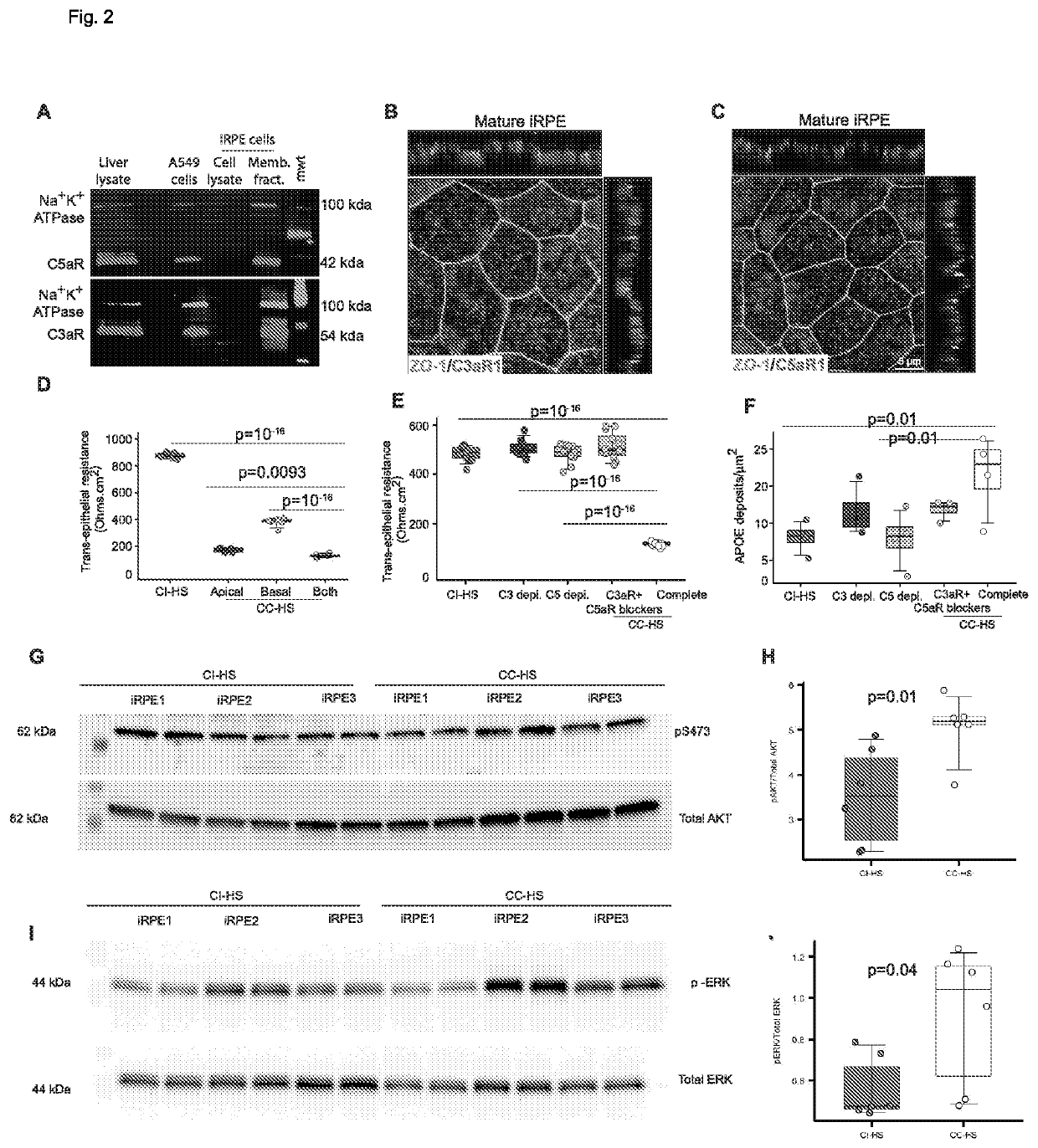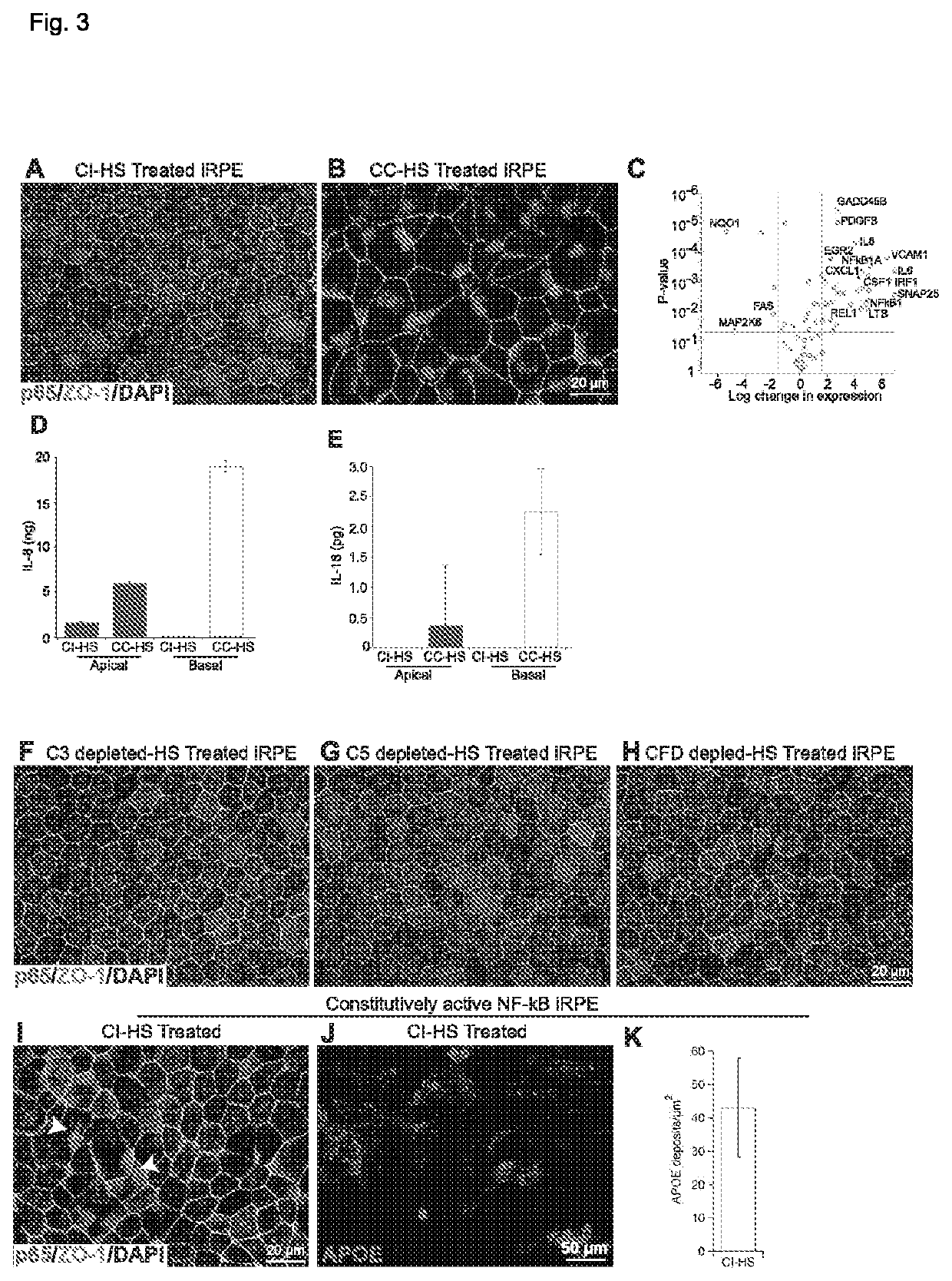Druggable target to treat retinal degeneration
a retinal degeneration and target technology, applied in the field of druggable target to treat retinal degeneration, can solve the problems of degeneration of neural retinal layer and hence vision loss, and no effective treatment for retinal degeneration
- Summary
- Abstract
- Description
- Claims
- Application Information
AI Technical Summary
Benefits of technology
Problems solved by technology
Method used
Image
Examples
example 1
t Competent Human Serum (CC-HS) Induces AMD-Like Cellular Endophenotypes in Mature iPSC-RPE
[0152]iPSCs derived from five different healthy individuals were used for this analysis. iPSCs were differentiated into mature RPE cells using previously published protocol (May-Simera et al., 2018, Sharma et al., 2019). Maturity of iRPE cells was confirmed by the presence of β-catenin on the cell membrane, (May-Simera et al., 2018, FIG. 1A) and by progressively increasing trans-epithelial resistance (TER) of the monolayer starting week 3 of culture (p−16, week 3 to weeks 4-6; FIG. 9A). Consistent with published reports for primary RPE cells (Johnson et al., 2011; Pilgrim et al., 2017), a five-fold increase in APOE positive sub-iRPE deposits was observed in CC-HS treated iRPE as compared to CI-HS treated cells (p9E, F). The presence of intracellular lipid deposits was further confirmed by transmission electron microscopy (TEM) of CC-HS treated iRPE cells (yellow arrowheads in FIG. 1H). TEM and...
example 2
ggered AMD Disease Phenotypes are Induced Through C3aR1 and C5aR1 Signaling
[0155]It was hypothesized that CC-HS triggered AMD cellular phenotypes in iRPE cells are generated by the anaphylatoxin arm of the complement pathway via C3a-C3aR1 and C5a-05aR1 signaling induced intracellular inflammation (Fernandez-Godino and Pierce 2018). RNAseq confirmed the expression of both receptors in iRPE cells with ˜30× higher expression in of C5aR1 as compared to C3aR1 (FIG. 10A). Furthermore, the expression of both receptors increases with CC-HS treatment. Western blot confirmed C3aR1 and C5aR1 receptors localization in the membrane fraction of iRPE cells (FIG. 2A). Their colocalization with the apical membrane marker EZRIN, but not with the basal membrane marker COLLAGEN IV suggests that the receptors for the two complement proteins, C3a and C5a, are predominantly apically located (FIGS. 2B, C, 10B). To verify that CC-HS activates C3aR and C5aR signaling in iRPE cells, samples were checked for p...
example 3
C5aR1 Induced subRPE Deposits are Mediated by Overactivation of NF-KB and Downregulation of Autophagy Pathways
[0156]RNAseq analysis of CI-HS and CC-HS treated iRPE cells revealed dramatically different global gene expression pattern induced by CC-HS treatment (FIG. 11A). Consistent with the effect of anaphylatoxin complement (C3a, C5a) in immune cells, autophagy (p−6) and TNF / NF-KB (p−5) pathways were the most changed by CC-HS treatment of iRPE cells (Freeley et al., 2016; Kumar 2019 Int Rev of Immu; Nguyen et al., 2018; FIG. 11B, C, D). This led us to hypothesize that C3aR1 and C5aR1 signaling in iRPE cells is working through these two pathways. CC-HS treatment indeed caused p65 (RELA) subunit of NF-KB to translocate to the nucleus, suggesting its activation (Rayet and Gelinas 1999, Oncogene; FIG. 3A, B). Nuclear translocation of p65 led to 4-6× increased expression of NF-KB target genes (Tilborghs et al., 2017), as confirmed by RNAseq (FIG. 11B, p−5), qRT-PCR-based validation of s...
PUM
 Login to View More
Login to View More Abstract
Description
Claims
Application Information
 Login to View More
Login to View More - R&D
- Intellectual Property
- Life Sciences
- Materials
- Tech Scout
- Unparalleled Data Quality
- Higher Quality Content
- 60% Fewer Hallucinations
Browse by: Latest US Patents, China's latest patents, Technical Efficacy Thesaurus, Application Domain, Technology Topic, Popular Technical Reports.
© 2025 PatSnap. All rights reserved.Legal|Privacy policy|Modern Slavery Act Transparency Statement|Sitemap|About US| Contact US: help@patsnap.com



